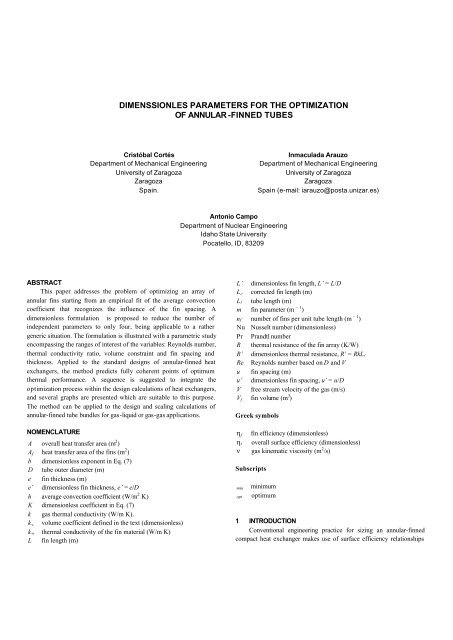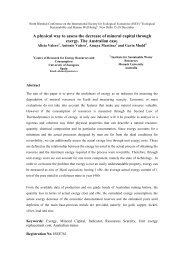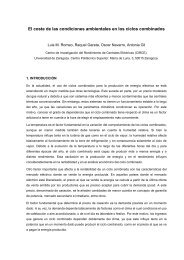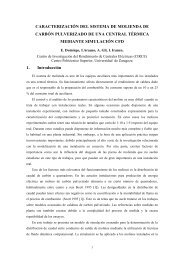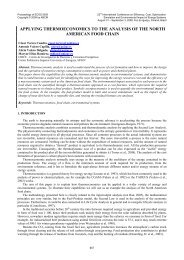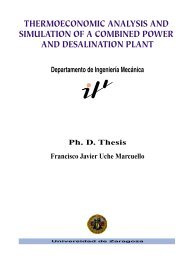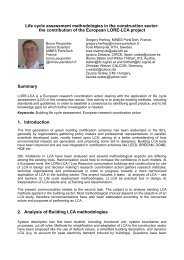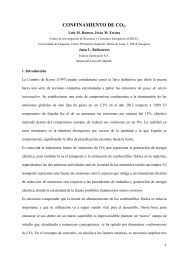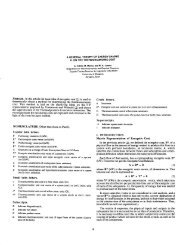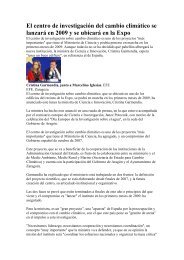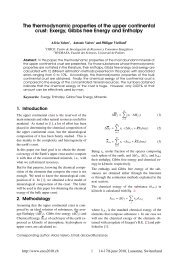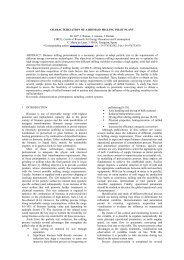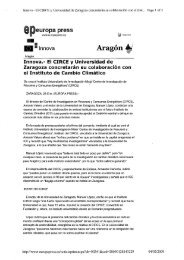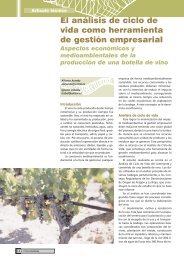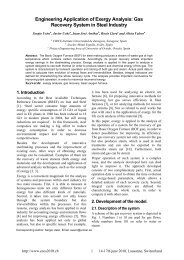finned tubes
finned tubes
finned tubes
You also want an ePaper? Increase the reach of your titles
YUMPU automatically turns print PDFs into web optimized ePapers that Google loves.
ABSTRACT<br />
This paper addresses the problem of optimizing an array of<br />
annular fins starting from an empirical fit of the average convection<br />
coefficient that recognizes the influence of the fin spacing. A<br />
dimensionless formulation is proposed to reduce the number of<br />
independent parameters to only four, being applicable to a rather<br />
generic situation. The formulation is illustrated with a parametric study<br />
encompassing the ranges of interest of the variables: Reynolds number,<br />
thermal conductivity ratio, volume constraint and fin spacing and<br />
thickness. Applied to the standard designs of annular-<strong>finned</strong> heat<br />
exchangers, the method predicts fully coherent points of optimum<br />
thermal performance. A sequence is suggested to integrate the<br />
optimization process within the design calculations of heat exchangers,<br />
and several graphs are presented which are suitable to this purpose.<br />
The method can be applied to the design and scaling calculations of<br />
annular-<strong>finned</strong> tube bundles for gas-liquid or gas-gas applications.<br />
NOMENCLATURE<br />
A overall heat transfer area (m 2 )<br />
Af heat transfer area of the fins (m 2 )<br />
b dimensionless exponent in Eq. (7)<br />
D tube outer diameter (m)<br />
e fin thickness (m)<br />
e’ dimensionless fin thickness, e’ = e/D<br />
h average convection coefficient (W/m 2 K)<br />
K dimensionless coefficient in Eq. (7)<br />
k gas thermal conductivity (W/m K).<br />
kv volume coefficient defined in the text (dimensionless)<br />
kw thermal conductivity of the fin material (W/m K)<br />
L fin length (m)<br />
DIMENSSIONLES PARAMETERS FOR THE OPTIMIZATION<br />
OF ANNULAR -FINNED TUBES<br />
Cristóbal Cortés<br />
Department of Mechanical Engineering<br />
University of Zaragoza<br />
Zaragoza<br />
Spain.<br />
Antonio Campo<br />
Department of Nuclear Engineering<br />
Idaho State University<br />
Pocatello, ID, 83209<br />
L’ dimensionless fin length, L’ = L/D<br />
corrected fin length (m)<br />
L c<br />
Lt tube length (m)<br />
m fin parameter (m – 1 )<br />
nf number of fins per unit tube length (m – 1 )<br />
Nu Nusselt number (dimensionless)<br />
Pr Prandtl number<br />
R thermal resistance of the fin array (K/W)<br />
R’ dimensionless thermal resistance, R’ = RkLt<br />
Re Reynolds number based on D and V<br />
u fin spacing (m)<br />
u’ dimensionless fin spacing, u’ = u/D<br />
V free stream velocity of the gas (m/s)<br />
Vf fin volume (m 3 )<br />
Greek symbols<br />
η f<br />
fin efficiency (dimensionless)<br />
ηt overall surface efficiency (dimensionless)<br />
ν gas kinematic viscosity (m 2 /s)<br />
Subscripts<br />
min<br />
opt<br />
Inmaculada Arauzo<br />
Department of Mechanical Engineering<br />
University of Zaragoza<br />
Zaragoza<br />
Spain (e-mail: iarauzo@posta.unizar.es)<br />
minimum<br />
optimum<br />
1 INTRODUCTION<br />
Conventional engineering practice for sizing an annular-<strong>finned</strong><br />
compact heat exchanger makes use of surface efficiency relationships
combined with an experimental correlating equation for the average heat<br />
transfer coefficient h on the <strong>finned</strong> surface. A good example of this<br />
procedure can be found for instance in the classical text book of Kays<br />
and London (1984a). The heat transfer literature offers many options<br />
for the estimation of h, ranging from generic and easy-to-use formulae<br />
which correlate the performance of a great variety of geometries<br />
(Schmidt, 1963) to specific data for standard configurations, reported<br />
in tabular or graphical form (Kays and London, 1984b).<br />
As in many other branches of engineering, the traditional<br />
approach naturally embodies strong simplifications. These have been<br />
progressively recognized along the advancement of experimental and<br />
numerical techniques. Due to the complexity of the flow induced by<br />
the extended surface, a high lack of uniformity in the local convection<br />
coefficient obtains, impairing the use of an average value (Schüz and<br />
Kottke, 1992). Likewise, as a result of the modified velocity patterns,<br />
a variable fin spacing leads to substantial changes in h that are not<br />
completely predicted by the conventional correlations (Watel et al.,<br />
1999).<br />
The general design of extended surfaces is certainly an specialized<br />
and complex matter, which requires expensive research tools, and<br />
whose results often become the object of proprietary knowledge.<br />
Nevertheless, for the modest objective of selecting and sizing the most<br />
suitable annular-fin geometry, the traditional method may take<br />
advantage of the recent developments in the field, at once retaining a<br />
notable simplicity.<br />
In particular, the variation of the correlated value of h raises the<br />
question of the optimization of <strong>finned</strong> tube arrays. For a given volume<br />
of fin material, the overall thermal resistance tends both to increase and<br />
decrease with the fin spacing, due to the simultaneous increase of the<br />
convective coefficient and decrease of the effective heat transfer area.<br />
Assuming from the start that a reliable empirical fit for h is<br />
available, this paper analyzes the problem from a theoretical and<br />
practical perspective. Firstly, the optimization is stated in terms of<br />
dimensional variables, deducing an implicit expression for the optimum<br />
fin spacing. Then, a non-dimensional formula is proposed, resulting in<br />
a remarkable simplification. The meaning of the corresponding<br />
dimensionless groups is also very appropriate to the problem in hand.<br />
A parametric study is subsequently undertaken for the usual<br />
ranges of the main variables. The optimum is calculated by means of<br />
standard numerical techniques. The results seem to be coherent, and<br />
several interesting trends are pointed out. Finally, as a kind of<br />
validation of the method, the classical geometries of annular-<strong>finned</strong><br />
<strong>tubes</strong> are examined in search of their optimum points of thermal<br />
performance. The results are again fully satisfactory, showing that a<br />
reasonable optimization was already present in the traditional designs.<br />
D<br />
u e<br />
Lt<br />
Figure 1. Geometry of an annular-<strong>finned</strong> tube.<br />
2 PROBLEM STATEMENT<br />
The problem is defined as the determination of the optimum<br />
arrangement of an annular-<strong>finned</strong> tube for a fixed volume of fin<br />
material. The optimum arrangement is the set of geometric parameters<br />
in Fig. 1 that leads to a minimum value of the thermal resistance of the<br />
fin array. The latter is expressed as<br />
1<br />
R =<br />
hη A<br />
t<br />
where the overall surface efficiency η t and area calculations are<br />
given by<br />
Af<br />
ηt = 1 − ( 1 − ηf<br />
)<br />
(2)<br />
A<br />
A<br />
f<br />
( 2 )<br />
⎛ Lt<br />
⎞<br />
⎛ D + L − D<br />
= π⎜<br />
⎟⎜<br />
⎝ u + e⎠⎜<br />
⎝ 2<br />
2 2<br />
L<br />
⎞<br />
+ ( D + 2L)<br />
e ⎟<br />
⎠<br />
⎛ u ⎞<br />
A = π DLt⎜<br />
⎟ + Af<br />
(4)<br />
⎝ u + e⎠<br />
In Eq. (2), the fin efficiency η f can be calculated with the wellknown<br />
results of 1D conduction theory. If a corrected length Lc = L +<br />
e/2 is combined with the exact solution for an adiabatic tip, η f is<br />
approximately independent of the Biot number, being a function of<br />
only two variables: the fin diameter ratio 1 + 2L’ + e’, where L’ = L/D<br />
and e’ = e/D are respectively the dimensionless fin length and<br />
thickness, and the dimensionless group<br />
mL<br />
c<br />
2h<br />
⎛ e ⎞<br />
= ⎜ L + ⎟<br />
k e ⎝ 2 ⎠<br />
w<br />
In order to close the specification of R, an adequate correlation for<br />
the average convection coefficient h is needed. The method of<br />
optimization can be developed for any empirical formula; in this study,<br />
we have selected a correlation recently reported in the literature (Watel<br />
(1)<br />
(3)<br />
(5)
et al., 1999), valid for Pr ≈ 0.7:<br />
k<br />
h = Nu ; Nu = 0.446X Re (6)<br />
D<br />
0. 55<br />
0. 55<br />
e K<br />
X<br />
u u b<br />
= + ′ ⎛ ⎞ ⎛<br />
−0.<br />
07 ⎞<br />
⎜1<br />
⎟ ⎜1<br />
− ⋅ Re ⎟<br />
(7)<br />
⎝ ′ ⎠ ⎝ ′ ⎠<br />
The Reynolds number Re = VD/ν is based on the tube diameter D<br />
and the free stream velocity V. The validity range is 2550 ≤ Re ≤ 42<br />
000. The dimensionless fin spacing is denoted u’ = u/D, and the<br />
constants K and b are given for two separate ranges of this parameter:<br />
K = 062 . , b = 0. 27⎫<br />
⎧0034<br />
. ≤ u ′ ≤ 014 .<br />
⎬ for ⎨<br />
(8)<br />
K = 0. 36, b = 055 . ⎭ ⎩ 014 . ≤ u ′ ≤ 0. 69<br />
To summarize, Eqs. (1)-(8) give the thermal resistance R as a<br />
function of the following variables:<br />
R = f (Re, k, kw, D, e, u, Lt, L) (9)<br />
Therefore, the ensuing formal statement is as follows: Minimize<br />
R, Eq. (9), for a fixed value of the fin volume<br />
V<br />
f<br />
π Lt e<br />
=<br />
4 u + e<br />
[ ( D + 2L)<br />
− D ]<br />
2 2 (10)<br />
If we select the fin spacing u as the dependent variable and<br />
eliminate the fin length L with V f , it follows that<br />
u opt = f(Re, k, k w, D, e, L t, V f) (11)<br />
the function f being implicitly described by all the foregoing equations<br />
when evaluated at the minimum value of R.<br />
3 DIMENSIONLESS VARIABLES<br />
Equation (11) is clearly useless for a general study. Consequently,<br />
we proceed to cast it in non-dimensional form. To this end, a new<br />
dimensionless variable can be conceived in a rather contorted but<br />
advantageous way. Suppose that all the material available is used to<br />
build a hollow cylinder whose inner diameter is D, the outer diameter<br />
of the tube. We may imagine it as the limit fin array that possess a<br />
spacing u = 0, and thus designate its thickness as L u=0. Now define the<br />
dimensionless coefficient k v > 1 as the diameter ratio of this imaginary<br />
cylinder. The volume V f is accordingly<br />
π<br />
[ ( 2 = 0) ] ( 1)<br />
2 2 2 2<br />
π<br />
Vf = Lt D + Lu − D = D Lt kv<br />
−<br />
4<br />
4<br />
(12)<br />
from which we can obtain k v as<br />
4V<br />
f<br />
kv = 1+ 2Lu′<br />
= 0 = + 1 2<br />
πD<br />
L<br />
or, equating Eqs. (10) and (12):<br />
k<br />
t<br />
(13)<br />
e′<br />
= 1 + [( 1+ 2 L′<br />
) −1]<br />
(14)<br />
u′ + e′<br />
2 2<br />
v<br />
It is only a question of algebraic manipulations to use this<br />
formula in Eqs. (3) and (4) in order to express the areas as<br />
A DL kv<br />
−<br />
f = t<br />
e′<br />
+ ′ + ′<br />
⎛<br />
π ⎜<br />
⎝ 2<br />
2 1<br />
( 1 2 )<br />
e L ⎞<br />
⎟<br />
u ′ + e′<br />
⎠<br />
(15)<br />
A DL kv<br />
− L e<br />
= t<br />
e′<br />
u e<br />
+<br />
′ ′<br />
′ + ′ +<br />
⎛ 2<br />
1 2 ⎞<br />
π ⎜<br />
1 ⎟<br />
(16)<br />
⎝ 2<br />
⎠<br />
Finally, a dimensionless thermal resistance is defined multiplying<br />
the specific value per unit tube length by the fluid thermal conductivity<br />
k:<br />
kLt<br />
R′ = kLt R =<br />
hη A<br />
t<br />
(17)<br />
The resistance R’ is given by Eqs. (2), (5)-(8), (15) and (16). An<br />
adequate inventory of the variables shows that the non-dimensional<br />
form of Eq. (9) is then<br />
kw<br />
R′ = f (Re, , e′ , u′ , L′ , kv<br />
) (18)<br />
k<br />
Now, as a consequence of the definition of the coefficient k v,<br />
fixing a volume V f of fin material is equivalent to fixing a value of k v for<br />
the same tube diameter D and length L t, Eq. (12). This statement<br />
connects the optimization problem with the other aspects of heat<br />
exchanger design, namely, the circulation of the inner fluid (D) and the<br />
heat rating for the selected geometry (L t). If we eliminate the<br />
dimensionless fin length L’ as a function of k v from Eq. (14), in view of<br />
Eq. (18) we arrive at<br />
kw<br />
u′ opt = f (Re, , e′ , kv<br />
) (19)<br />
k<br />
This expression can be regarded as the proper dimensionless form<br />
of Eq. (11). In conclusion, the dependence of the optimum spacing on<br />
four geometric parameters (D, e, Lt and Vf) has been reduced to uopt ′<br />
being a function of only two: the dimensionless fin thickness e’ and the
volume coefficient k v.<br />
4 PARAMETRIC STUDY<br />
In order to demonstrate the advantages of the proposed method, a<br />
parametric study has been undertaken for typical values of the<br />
independent dimensionless variables. These are shown in Table 1. The<br />
Reynolds numbers have been chosen in accordance with common<br />
design practices for gas flow. The range of e’ is that found in standard<br />
geometries of compact heat exchangers (Kays and London, 1984b).<br />
The value at the base case coincides with the one experimentally tested<br />
when deriving the correlation adopted for the convection coefficient<br />
(Watel et al., 199). Three thermal conductivity ratios have been set<br />
considering representative figures for the fin material (k w = 50, 100 and<br />
150 W/m K) and air at 350 K (k = 0.03 W/m K).<br />
The volume coefficient k v has been parametrized in 46 different<br />
values, from k v = 1.05 to k v = 1.5, in steps of 0.01. Again, this range<br />
widely covers the habitual design practices. The optimization has<br />
proceed by minimizing the function R’ with u’ as the dependent<br />
variable. The golden section search algorithm has been used, as<br />
implemented in a commercial solver (Klein and Alvarado, 1992).. The<br />
criteria of convergence was a relative error less than 0.1%.<br />
Table 1. Dimensionless values for the parametric study<br />
Re e’ k w/k<br />
minimum 2 500 0.01 1 666<br />
base case 10 000 0.017 3 333<br />
maximum 40 000 0.047 5 000<br />
The results are shown graphically in Figs. 2, 3 and 4. In the first<br />
place, Fig. 2 is a plot of the calculated minimum thermal resistance vs.<br />
the volume coefficient, over the studied range of kv. Logically, Rmin ′ decreases with the volume, and the effect of the<br />
optimization is more pronounced the less material is available.<br />
The most influential parameter turns out to be the Reynolds<br />
number, followed by the fin thickness. The latter means that there will<br />
be several possibilities for optimizing a given situation. Limitations in<br />
e’ dictated by the material or the manufacturing method will play an<br />
important role. The effect of the ratio kw/k is very small, a fortunate<br />
circumstance, since it is almost completely determined by the gas<br />
temperatures and the fin material.<br />
R' min<br />
0.0035<br />
0.0030<br />
0.0025<br />
0.0020<br />
0.0015<br />
0.0010<br />
0.0005<br />
104 0.017 3333 104 Re e' kw /k Re e' kw /k<br />
0.017 1666<br />
10 4 0. 010 3333<br />
10 4 0.047 3333<br />
104 0.017 5000<br />
4.10 4 0.017 3333<br />
2.5.10 3 0.017 3333<br />
0.0000<br />
1 1.1 1.2 1.3 1.4 1.5<br />
kv Figure 2. Minimum value of R’ vs. k v.<br />
The graphs in Figs. 3 and 4 represent the variation of uopt ′ with kv for the base case and extreme values of e’ and Re, respectively. The<br />
trends are very reasonable. For the same volume of fins, the optimum<br />
spacing increases with their thickness and decreases with the Reynolds<br />
number, since the latter allows a lower value of e’ with identical h. The<br />
step in the curves is caused by the lack of continuity of the correlation<br />
given by Eqs. (6)-(8) at u’ = 0.14. The asymptotic character of some<br />
curves is also artificial, since the optimization was constrained within<br />
the specified correlation range for the dimensionless thickness, Eq. (8).<br />
0.7<br />
u' opt<br />
0.6<br />
0.5<br />
0.4<br />
0.3<br />
0.2<br />
0.1<br />
0<br />
e' = 0.010<br />
e '= 0.047 Re = 10 4<br />
k w /k = 3333<br />
e' = 0.017<br />
1 1.1 1.2 1.3 1.4 1.5<br />
kv
u' opt<br />
0.7<br />
0.6<br />
0.5<br />
0.4<br />
0.3<br />
0.2<br />
0.1<br />
Figure 3. Optimum spacing vs. kv and fin thickness.<br />
0<br />
Re = 2500<br />
Re = 10000<br />
Re = 40000<br />
1 1.1 1.2 1.3 1.4 1.5<br />
kv<br />
e' = 0.017<br />
kw /k = 3333<br />
Figure 4. Optimum spacing vs. kv and Reynolds number.<br />
5 RESULTS FOR STANDARD GEOMETRIES<br />
The method of optimization has been applied to the geometries of<br />
compact, annular-fined tubular heat exchangers whose thermal<br />
performance data was compiled by Kays and London (1984b),<br />
Table 2.
Table 2. Geometries of standard annular-<strong>finned</strong> <strong>tubes</strong>.<br />
surface designation D (mm) L (mm) L’ e’ u’ n f (m –1 ) V f ·10 5 (m 3 ) k v<br />
CF-7.34 9.650 6.86 0.711 0.0474 0.3105 289 4.708 1.28<br />
CF-8.72 9.650 6.86 0.711 0.0474 0.2545 343 5.583 1.33<br />
CF-8.72(c) 1.067 5.60 0.525 0.0448 0.2257 343 4.741 1.24<br />
CF-11.46 9.650 6.86 0.711 0.0421 0.1876 451 6.520 1.38<br />
CF-7.0-5/8J 1.638 6.05 0.369 0.0155 0.2060 276 2.981 1.07<br />
CF-8.7-5/8J 1.638 6.05 0.369 0.0155 0.1626 343 3.708 1.08<br />
CF-9.05-3/4J 1.966 8.75 0.445 0.0155 0.1273 356 8.481 1.13<br />
CF-8.8-1.0J 2.601 9.05 0.348 0.0117 0.0993 346 10.530 1.09<br />
First of all, our estimation after Watel et al. (1999) correlation of<br />
the average convection coefficient has been confronted with the original<br />
data, which essentially encompasses the same interval of Reynolds<br />
numbers. Deviations in the value of Nu range from 5 to 15 %,<br />
depending on Re and the geometry. This is deemed to be acceptable for<br />
a general correlation formula. Curiously, the measurements in Watel et<br />
al. (1999) are systematically higher than the values reported in by<br />
Kays and London (1984b), in spite of the fact that the former refers to<br />
a single tube and the latter to a tube bundle.<br />
Figure 5 shows the curves uopt ′ vs. Re for the eight geometries<br />
considered. The design value of u’ is indicated in the left ordinates. It<br />
can be observed that each geometry becomes the optimum for a<br />
Reynolds number that lies always within the expected range of<br />
operation. Therefore, the proposed method seems to be coherent with<br />
the traditional design procedures.<br />
u' design<br />
CF-7.34<br />
CF-8.72<br />
CF-11.46<br />
CF-9.05-3/4J<br />
CF-8.72(c)<br />
CF-8.8-1.0J<br />
CF-7.0-5/8J<br />
CF-8.7-5/8J<br />
u' opt<br />
0.35<br />
0.25<br />
0.15<br />
0 5000 10000 15000 20000 25000<br />
0.05<br />
30000 35000 40000<br />
Re<br />
Figure 5. Curves u’opt vs. Re for the geometries of Table 2.<br />
0.3<br />
0.2<br />
0.1<br />
6 CONCLUSIONS<br />
A method of optimization of annular fin arrays has been<br />
discussed, based on an original dimensionless form of the heat transfer<br />
relationships, and a given empirical formula for the average convection<br />
coefficient. The results are completely coherent and agree well with<br />
standard fin geometries already optimized by the experience. It can be<br />
useful in engineering design, as well as scaling-up, of compact heat<br />
exchangers for gas-liquid or gas-gas applications.<br />
A possible use of the method would consist in the following<br />
sequence:<br />
1 Determine the required value of R’ as dictated by the energy<br />
balance and the heat transfer calculations, taking into account, if<br />
relevant, the thermal resistance of the inner fluid and the possible<br />
fouling.<br />
2 From the values of V and D (as determined by flow and pressure<br />
drop requirements), calculate Re.<br />
3 Select the fin thickness and material, thus fixing the parameters e’<br />
and k w/k.<br />
4 With the aid of Fig 2., determine the minimum amount of material<br />
needed to build the fin array with the prescribed value of R’.<br />
5 A plot of the style of Fig. 3 or 4 for the adequate value of the<br />
variables allows the determination of the fin spacing u’. Equation<br />
(14) then gives the fin length L’.
7 REFERENCES<br />
Kays, W. K., and London, A. L., 1984a, Compact Heat<br />
Exchangers. Third Edition, McGraw-Hill, New York, 1984, chap. 2.<br />
Kays, W. K., and London, A. L., 1984b, Compact Heat<br />
Exchangers. Third Edition, McGraw-Hill, New York, 1984, chaps. 9<br />
and 10.<br />
Klein, S. A., and Alvarado, F. L., 1992, EES: Engineering<br />
Equation Solver. Reference manual, F-Chart software, 1992, Appendix<br />
B.<br />
Schmidt, Th. E., 1963, “Der Wärmeübergang an Rippenrohren und<br />
die Berechnung von Rohrbündel-Wärmeaustaus-chern”, Kältetechnik,<br />
vol. 12, pp. 370-378, 1963.<br />
Schüz, G. and Kottke, V., 1992 “Local Heat Transfer and Heat<br />
Flux Distributions in Finned Tube Heat Exchangers”, Chem. Eng.<br />
Technol., vol. 15, pp. 417-424, 1992.<br />
Watel, B., Harmand, S., and Desmet, B., 1999 Influence of Flow<br />
Velocity and Fin Spacing on the Forced Convective Heat Transfer from<br />
an Annular-Finned Tube, JSME Int. J. Series B, vol. 42, pp. 56-64,<br />
1999.


